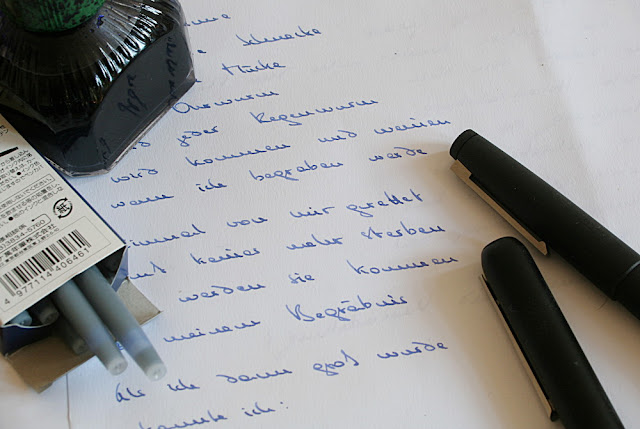Nakaya! Nakaya! ... And some musings about Urushi
Since I've got my Long Cigar in heki-tame nuri (green-brown) there's four Urushi colours in my pen family and I felt like taking a group photo! Each pen looks gorgeous on its own but even more so together.
 |
| Nakaya kuro-tame, aka-tame, heki-tame and shiro-tame nuri. |
Tame-nuri is a traditional Japanese lacquering technique which involves two colours of lacquer applied over each other. I don't really know a terrible lot about that so if anyone detects a mistake I'd be happy to be corrected! Here's what I know:
Raw Urushi lacquer will be semi-transparent with a brownish tinge. It will also be poisonous up to the extent of causing an allergic shock and it won't dry at all unless exposed to warm and humid conditions. The saturation of the colour will vary depending on how many layers of Urushi are applied, and every Urushi-coated pen will usually see many, many thin layers of it.
At Urushi Kobo Europe I found auseful resource on Urushi and some interesting pictures. Fountain pens are in fact pretty much a niche for Urushi use, more commonly it is used for tableware, vases, little storage cabinets and other decorative items. It was even more widespread in the past before synthetic lacquers and plastics became widely available. Even Samurai armor is said to have been coated with it.
 |
| Nakaya Piccolo Writer, Portable Cigar, Long Cigar, Piccolo Cigar. |
Back to tame-nuri and its two colours. The lighter colour will be applied first. From left to right in the above picture it will be red, red again, green and white. Urushi can be coloured in all shades of the rainbow by adding pigments to the liquid. The shown colours are pretty traditional. Red was one of the earliest Urushi colours and was achieved by adding cinnabar.
Once the underlayer is complete another colour will be added. From left to right that would be black, red, brown and - totally not sure about the last one, maybe brown to or even uncoloured Urushi? From looking at the pen the two colours will now be as one, but at the edges the undercolour will still show. Also due to the semi-transparency of the Urushi lacquer small colour irregularities can be seen under the surface.
Someone once described looking at Urushi lacquer as looking into a deep, clear pond and that's an astonishingly fitting description. It has a depth to it that doesn't compare to your lacquered car, furniture or fingernails. ;-)
More advanced traditional techniques of Urushi lacquer works are Raden and maki-e. Once I get decent photos done I'm planning to do a post on these as well.
 |
| Nakaya Long Cigar in heki-tame nuri, with friends. |
For reasons unknown to me the colours often show even better on the sections of the pens. Tobacco brown and seladon green - didn't assume it would look good together? Neither did I. But here goes.
















































